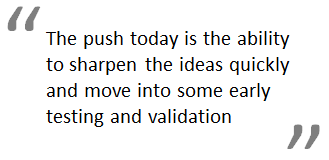 The shape of our collaboration activities has been radically changing in recent years.
The shape of our collaboration activities has been radically changing in recent years.
The combination of technology, the internet, resource constraints and the opening up of innovation to the outside world has changed the shape and content of conversations.
Shaping conversations can be either intentional or through serendipity. Ideas are usually never fully formed but emerge over these conversations, from fragments that need nurturing, encouraging, aligning and developing through ongoing conversations. Often the fragments need a wider network to come together and form around.

The push today is the ability to sharpen the ideas quickly and move into some early testing and validation, ideally with the final customer somehow engaged and then from this ‘interaction’ the idea shapes and its final understanding deepens onto a concrete delivery.
There is a growing need for more radical, out of the existing box innovation to tap into. Collaborators help here.
Continue reading “Exploring the criteria for collaborative activities within innovation”

